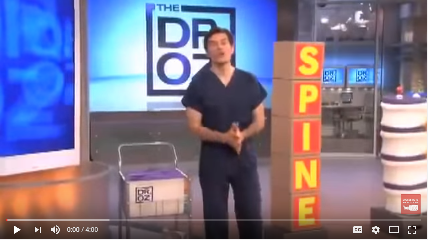Dr. Oz Gropes Katie May
The fallout from the Katie May accidental death resurfaced in the media on The Dr. Oz Show. When I first learned this topic would be discussed on that show, I feared the worse that Dr. Oz would pile on the death of Katie May, a Playboy model, with the typical Chicken Little journalism similar to the recent Witch Hunt Down Under when an innocent pediatric chiropractor was convicted in the court of public opinion with an onslaught of yellow journalism never seen there before.
My trepidation about The Dr. Oz Show stems from a study concerning medical talk shows where investigators from the British Medical Journal randomly selected 40 episodes of each of The Dr. Oz Show and The Doctors from early 2013 and evaluated all recommendations made on each program. This study concluded that “only a third to one half of recommendations are based on believable or somewhat believable evidence.”[1]
Unfortunately, my worst fears were also stoked when I saw the scandalous title, Breaking News: Can Your Chiropractor Kill You?

This title sent shivers down my spine because it unquestionably prejudiced his viewing audience, reminding me of the proverbial “gotcha” question asked in divorce cases: “How long has it been since you last beat your wife?”
By definition a “gotcha” question is one that puts people on the spot, implies wrongdoing, is emotionally charged, and has no good answer—confirming makes you look bad, denying makes you look weak and asking for time to think makes you look like a weasel.[2]
As an example of a misleading “gotcha” headline, I purposely used the verb “grope” in the title of my article, “Dr. Oz Gropes Katie May,” to show how it can mislead readers in the same manner. By definition, grope has two meanings: 1) to search for something you cannot see or find easily (which is certainly the facts surrounding Katie May’s death) and 2) to touch someone in an unwanted and unexpected sexual way (which is what most people would assume about a Playboy model).

Obviously Dr. Oz and his panel were searching for an explanation of Katie Mae’s death, but my title superficially may suggest to many people Dr. Oz had fondled her. Using a word open to two very different interpretations, one of which is usually risqué or indecent, shows how dangerous this double entendre can be, especially to readers who already have a chirophobic attitude or those who don’t read past the headline.
Undoubtedly during this “sweeps” week the producers were more interested in provocative stories, which may explain why they didn’t use a less sensational headline, such as “New Facts about Katie May” or “Dr. Oz, a Chiropractor, and MD Discuss the Death of Katie May.”
Despite the horrendous title for this segment, fortunately, the actual content of the Dr. Oz program was deemed fair and balanced by all observers. If Dr. Oz were not friendly to the chiropractic profession evident by his previous segments, another unfair and imbalanced attack by him would have been fatal to our image.
Dr. Oz Explains Chiropractic Care

Steven Shoshany, DC, a previous guest on Dr. Oz’s show, did an admirable job representing chiropractic care and Dr. Carolyn Brockington, a stroke radiologist, was very considerate without the chirophobia I expected, explaining dissections are “very common” among young healthy adults and “most dissections don’t result in stroke.”
Dr. Oz also mentioned he was stunned to learn dissections comprise 20% of strokes in people 45 and younger. Dr. Shoshany mentioned the likelihood of a stroke following manipulation is a 1 in 6 million. He also said none of the 17 American chiropractic colleges have reported a case and he mentioned the relative safety compared to opioid painkillers.
Overall, the tone of the discussion between Dr. Shoshany, Dr. Brockington and Dr. Oz was very cordial and informative. Even the segment with Katie May’s siblings was not acrimonious toward chiropractors despite the recommendation one made that patients should seek their MD’s advice before seeing a DC.
I find it odd they still trust the same MDs who brought America the attack of opioids we now have decimating our country at a record of 28,647 deaths in 2014 or 78 people a day from prescription synthetic opioids such as OxyContin, Percocet, Hydrocodone or Vicodin, and natural opiates like heroin according to the CDC.[3]
Undoubtedly this is a prime example of “truthiness” involved when it comes to the image of MDs who can do no harm in the minds of many.
The Rest of the Story
All in all, these Dr. Oz segments discussed on November 16, 2016, were better than I expected although we all would like to see another program comparing medical vs. chiropractic spine care.
If Dr. Oz’s producers were “fair and balanced,” they could have elaborated in another segment on the topic of neck treatments by comparing the truth about medical vs. chiropractic spine care as the following Gallup-Palmer graph illustrates.

As this chart shows, if the Dr. Oz producers want a scandalous program about spine care, there is plenty of evidence to scare the public about medical spine treatments.
The downside revelation of medical spine care is not new considering there have been many impactful articles in major media outlets over the past few years that have revealed this huge issue; the problem remains none have been mentioned on any national news television programs.
Damage Control
The Dr. Oz segment is proof that one program in the earned media is worth its weight in gold compared to social media if we are to rehabilitate our image.
In my previous article, Media Muckraking, I showed other examples of “damage control” worth repeating by Chipotle, BP, and Wells Fargo. Now it’s our time to develop an on-going PR Workshop to develop new speakers, new writers and to instill in our college students their need to carry on this fight in the court of public opinion.
For example, recently the STAT online newsletter carried an article, “How do we decrease addiction to opioids but still treat millions with chronic pain?” that made no mention of chiropractic care despite the fact low back pain is the leading condition for opioid prescriptions and the leading cause of disability in the workplace, the military and in the VA.
This is not the first time chiropractic care has been the proverbial “elephant in the news room” concerning the pandemic of back pain, such as the CDC snubbing chiropractic in its “Guideline for Prescribing Opioids for Chronic Pain — United States, 2016.”
Keep in mind we chiropractors constitute the third-leading physician-level health profession in the world that offers effective nondrug and nonsurgical solutions to this pandemic of pain. Even the Joint Commission and the North American Spine Society Evidence-Based Clinical Guidelines for Multidisciplinary Spine Care for the “Diagnosis and Treatment of Lumbar Disc Herniation with Radiculopathy” are now touting the benefits of spinal manipulation for back pain and sciatica.
If this Katie May issue doesn’t unite every faction in chiropractic both here and abroad no matter the different philosophies, ideologies, techniques or sexual preferences, what will it take to discuss this important issue that at the upcoming conference?

[1] Christina Korownyk, et al., Televised medical talk shows—what they recommend and the evidence to support their recommendations: a prospective observational study, BMJ 2014;349:g7346 Research Christmas 2014: Media Studies Published 17 December 2014
[2] https://www.quora.com/What-is-the-difference-between-asking-a-gotcha-question-and-a-tough-question-in-interviewing